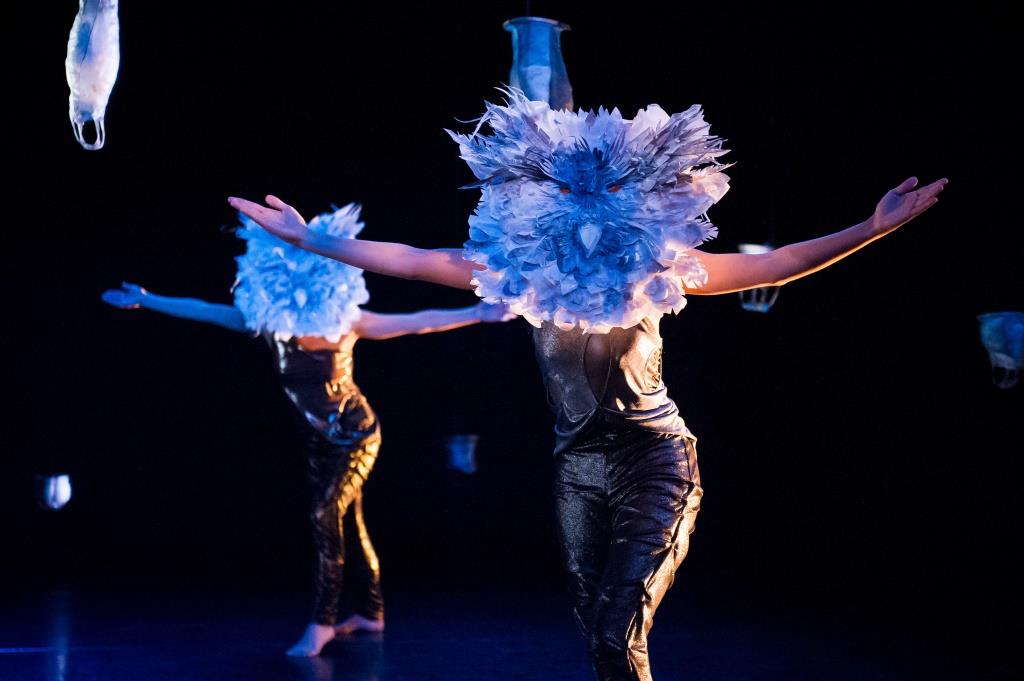
Emily Johnson/Catalyst weaves story, dance, music and art-making into a new work, “Niicugni”
The O’Shaughnessy was quieter than usual before last night’s show, particularly given the size of the crowd that braved the rain to see Emily Johnson/Catalyst’s one-night-only regional premiere of “Niicugni.” The light was dim, and there were homemade lanterns suspended from the rafters above both stage and audience, but little else by way of props or sets. According to the program notes, the lights hanging above our heads were 50-some hand-sewn fish skin lanterns, made by volunteers in Minnesota, Vermont, California, Arizona and Alaska participating in residency workshops led by Johnson over the last year. The light they cast is gentle, like candlelight in a darkened room.
The lanterns go out and the show opens in darkness: a pair of figures undulates on the floor in concert, languid like swimming fish. Angie Vo’s costume designs fit close to the body, simply but cleverly designed so that the softly scalloped texture of the fabric ripples as the dancers move. Fish skin lanterns flicker on and off, casting the duo in shifting currents of light; eventually the darkness recedes enough to see that our two figures are wearing paper masks, each printed with her own face. The movement bleeds into storytelling – Johnson whispers to her partner and to us: “Remember? That story about the monster who bit off my ear? I’ll tell it again.” At which point, she begins to recite a story of incremental loss and a string of intrusions into her body – an intimate recounting of colonial conquest and rape of both land and indigenous people.
In the program is Johnson’s short statement about the work; she describes “Niicugni,” (a Yu’pik word meaning “listen,” or “pay attention”) as a dance, but much more, too: “It is a story made of many. …There is hope here, and death; monsters and laughter; salmon, bear, blood, and a never-ending attempt to pay attention. I think of the land beneath our feet. I think of everyone in this room.”
She goes on to recount summers spent every year in her native Alaska, where her family gathers at the time of the Sockeye run to “fish, then clean, fillet, de-bone, strip, brine, kippur, freeze, smoke, can, and feast on the fish that will feed our family for the year.” It’s an annual ritual of sustenance and thanks – for the fish and land and generations of family tradition, largely unchanged for thousands of years. It’s also the heart of Johnson’s performance work. Once she learned the indigenous techniques behind making fish-skin lanterns, Johnson writes, she found the nature of the activity – its rootedness in place and necessity and community effort – consummated all that personal memory and tradition in a way that galvanized her dance. “So now,” she writes “‘Niicugni’ is also people gathering to sew.”
It’s the second in a trilogy of dance works inspired by Johnson’s Yu’pik heritage, and like 2010’s “The Thank-You Bar,” this is not a traditional sit-and-watch sort of show. Johnson aims to envelope her audience in the interwoven experiences of home, ancestral memories and mythic history. In “Niicugni,” movement, costume and lighting are stitched together with music, video and spoken word, collaborative art-making and audience engagement. The contribution of each – dancer, lighting tech, musician and community member – is made transparent, a quilted experience, jointly made. And it’s clear Johnson intends the seams of that homespun effort to show.
Musician (and Johnson’s husband) James Everett and Bethany Lacktorin created an original score for “Niicugni” – atmospheric instrumentals, punctuated by an ebb and flow of percussion, with guitar and violin solos. Everett and violinist Lynn Bechtold perform much of the work live, as part of the movement on stage.
Lighting designer and longtime collaborator, Heidi Eckwall, periodically runs on stage to perform an exuberant gesture or offer a quick, impromptu-seeming story – her only costume a t-shirt bearing her own face. The dance at the work’s heart – by Johnson and Vancouver-based artist, Aretha Aoki – feels at once improvisational and deeply familiar, ritualized but also keenly felt and in-the-moment.
Production photo of “Niicugni” courtesy of Northrop. Photo by Ian Douglas
During the course of the evening, individuals stand and emerge from the audience to cluster on stage, joining the movement for a few minutes. In the after-show talk-back, Johnson says she tapped groups of individuals representing a cross-section of the community, 40 or so amateur dancers in total – seniors from a water aerobics class at the local Y, student dancers from St. Paul Conservatory for Performing Arts, urban gardening enthusiasts, and fish-skin sewers from the Minneapolis cohort of volunteers.
All of which combines to lend the work an intimacy that belies the abstruse poetry in Johnson’s amalgam of organic gesture and storytelling and mythic imagery. “Niicugni” is as much a kind of worship service, a prompt for meditation, as it is a dance. According to the program, Northrop Dance has commissioned the third installment in her series, “SHORE,” for 2014. I’m eager to see where Emily Johnson and the Catalyst collaborators take this thread next.
“Niicugni” by Emily Johnson/Catalyst was on stage Sunday, April 21 in The O’Shaughnessy at St. Catherine University in St. Paul, presented by Northrop Concerts and Lectures as part of their Women of Substance series this year. For more information: http://catalystdance.com/.
Recent Content
-
Artsarticle ·
-
Artsarticle ·
-
Artsarticle ·


